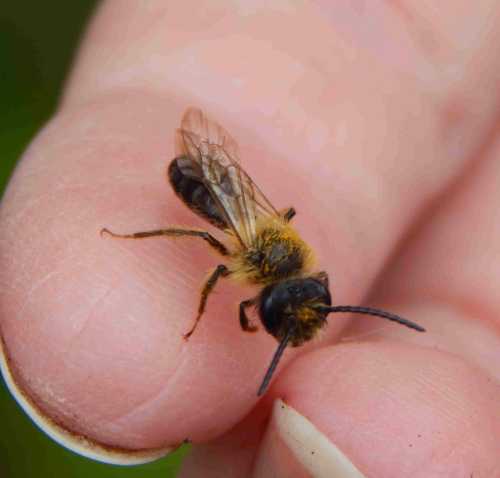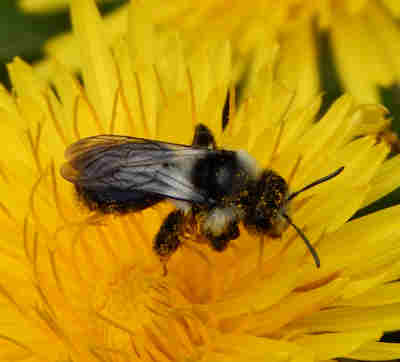Colletes cunicularius - Vernal Mining Bee
Updated: 25th February 2021
Also known as Early colletes; Vernal mining bee; Spring mining bee; Spring colletes; Vernal colletes.
This enchanting bee - Colletes cunicularius has several common names as listed above, from 'Early mining bee' to 'Vernal mining bee'.
However, interestingly the Latin name Colletes cunicularius appears to refer to neither of the common names given, with no mention of 'spring', 'vernal' or 'early'. As discussed elsewhere on this site, 'Colletes' means 'one who glues'. 'Cunicularius' means 'burrows' or 'miner'.
About Colletes cunicularius
This is the largest Colletes in Britain, with females approximately 10-11mm in length, and males recorded as slightly smaller and slimmer (9.5mm - 10.5mm).
 Above: Vernal mining bee - also known as the Spring mining bee, or Early mining bee. Female.
Above: Vernal mining bee - also known as the Spring mining bee, or Early mining bee. Female.Males have paler hair than females, the latter being rather dark in appearance.
 Above: A handsome Colletes cunicularius - Vernal mining bee - Male.
Above: A handsome Colletes cunicularius - Vernal mining bee - Male.Falk (author of Field Guide to Bees Of Great Britain And Ireland) notes that in males "the abdomen can give the impression of hair bands from some angles though these consist of long hairs".
 Colletes cunicularius - Vernal mining bee - Male.
Colletes cunicularius - Vernal mining bee - Male.Colletes cunicularius - flight season
Not surprisingly given its name, it is one of the early Colletes bees to emerge and can be seen in the UK from early March to May or sometimes June.
 Above: A Colletes cunicularius - Vernal mining bee - taking off from the sandy ground. Male.
Above: A Colletes cunicularius - Vernal mining bee - taking off from the sandy ground. Male.
As I write, its actually July (just!), but I took most of these photographs in May - I simply haven't had time to upload them previously due to personal commitments!
Colletes cunicularius - habitat
This species is native to particular habitat ranges within the UK and also Europe and appears to favour locations with sand dunes. In these areas, the bees nest in south-facing slopes, and the sand is soft and loose.
All apart from one of these photographs were taken at an SSI (Site of Special Scientific Interest) in North Wales, UK where this species is known to nest - in fact, there is a notice and photographs on the information board for the site. It's the same location where I have photographed the silvery leafcutter bee, among others.
 Above: Vernal mining bees can typically be seen around sand dunes where they nest in burrows.
Above: Vernal mining bees can typically be seen around sand dunes where they nest in burrows.Nesting habits of Colletes cunicularius
 Above: Colletes cunicularius outside a tunnel entrance. Female.
Above: Colletes cunicularius outside a tunnel entrance. Female.Colletes cunicularius nest in burrows in the sand. BWARs (Bees, Wasp and Ant Recording Society) notes that these burrows are typically 45 - 55 cm deep1, with cells built at the end of side branches, but others note that tunnels can reach as deep as 80cm2 .
Being a member of Colletes, as with other plasterer bees this species lines its nest cells with a cellophane-like membrane that serves to protect against bacteria and fungi, whilst also acting as a waterproof barrier.
Foraging preferences of Colletes cunicularius
It had previously been assumed that this species was oligolectic, foraging chiefly on willows (Salix) for pollen, and especially associated with Creeping Willow (Salix repens) at sand dune sites.
However, a study3 comparing pollen preferences of another early mining bee species, Andrena varga and Colletes cunicularius found that this is not correct.
Pollen loads that had been collected by Colletes cunicularius were analysed and found to contain not only Salix, but also a significant percentage of other pollens, including from Sorbus aucuparia (rowan), Prunus padus (bird cherry), Prunus rocerasus (cherry laurel), Malus (apples), Sambucus niger (elder), Ranunculus sp (buttercups), Euonymus europaeus (European spindle), Quercus (oak) and Ilex (holly).
According to the study, the percentage of other pollen types increased toward the end of the flowering season for Salix.
At this particular SSI, other willows and dandelions (Taraxacum) are also appealing.
Status
In Britain, this species is considered rare, and features on a number of lists2:
- IUCN (pre-1994): Rare
- General provisions of the Wildlife & Countryside Act,
- 1981 Species of Conservation Concern List, v1
- Long list of Globally Threatened & Declining Species (1995), v1
Predators
A key predator is Sphecodes albilabris in Europe. This species is not recorded in Britain, however, I certainly noted a Sphecodes species prowling nearby!
 Above: Could this be Sphecodes pellucidus?
Above: Could this be Sphecodes pellucidus?Unfortunately, I was unable to capture a very clear photograph, however, if not albilabris, I wonder if it could be Sphecodes pellucidus - the Sandpit Blood bee.
It is known to be a predator of Andrena barbilabris, but Falk notes that this species is sometimes absent where Sphecodes pellucidus is present, suggesting that it might be bivoltine and using other hosts at some sites.
 Above: I believe this is a Sphecodes lurking around the nesting site of the Vernal Mining Bee.
Above: I believe this is a Sphecodes lurking around the nesting site of the Vernal Mining Bee.Sphecodes are cleptoparasites of various ground nesting bee species. The images above are of females - these are the first to appear (at least with most Sphecodes species), and they seek out nests of their target host in which to lay their eggs.
Upon locating a suitable host nest, they enter, open up a cell, destroy the grub or egg of the host species currently inside and promptly replace it with their own egg. They then reseal the nest cell before leaving the host nest.
References
(1) http://www.bwars.com/bee/colletidae/colletes-cunicularius
(2) https://blogs.edgehill.ac.uk/biologyplacement/files/
2017/04/Flagship-Species-Fact-File-Vernal-Mining-Bee.pdf
3. Bischoff I., Feltgen K., Breckner D. (2016). Foraging Strategy and Pollen Preferences of Andrena vaga (Panzer and Colletes ciinicularius (L .) (Hymenoptera: Apidae).
Read about the Chocolate Mining Bee


